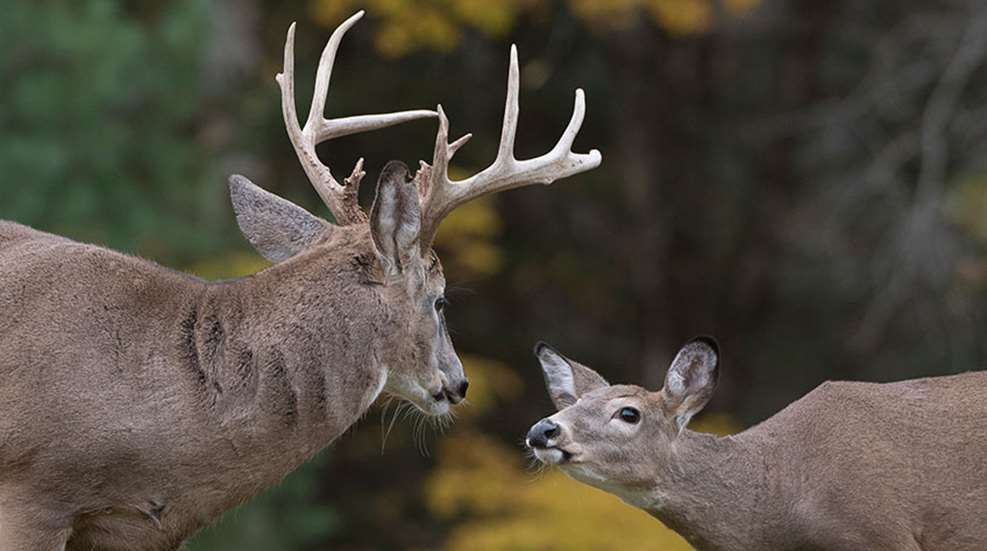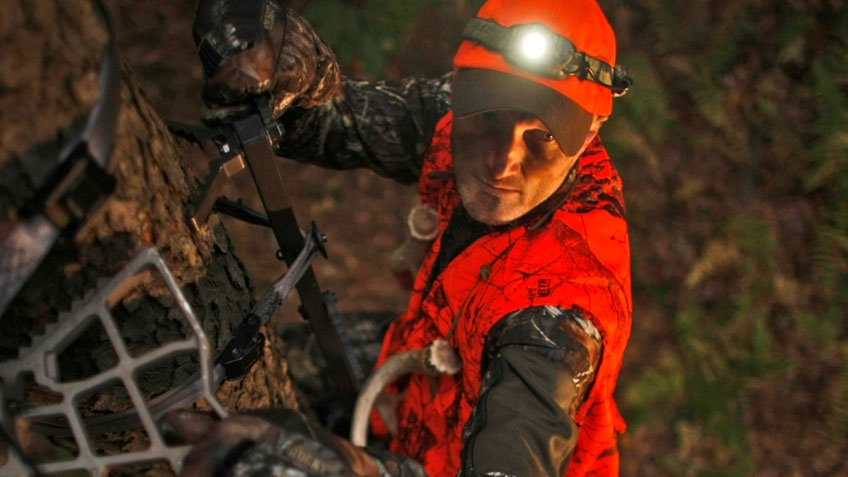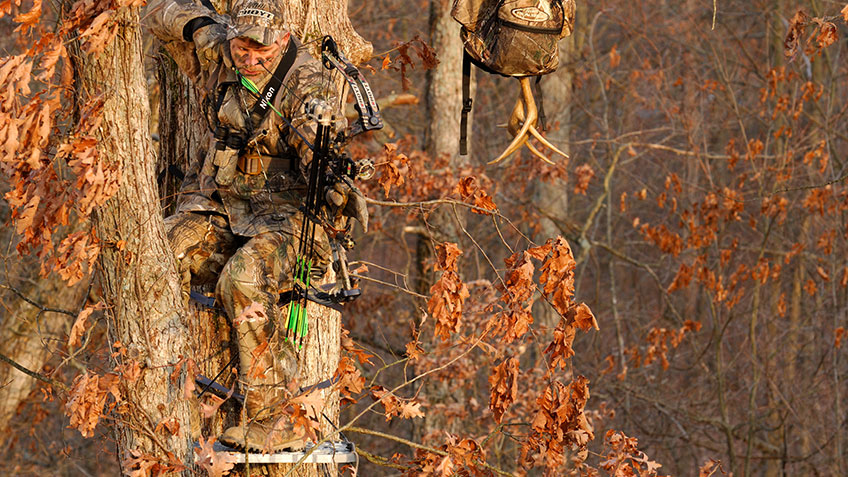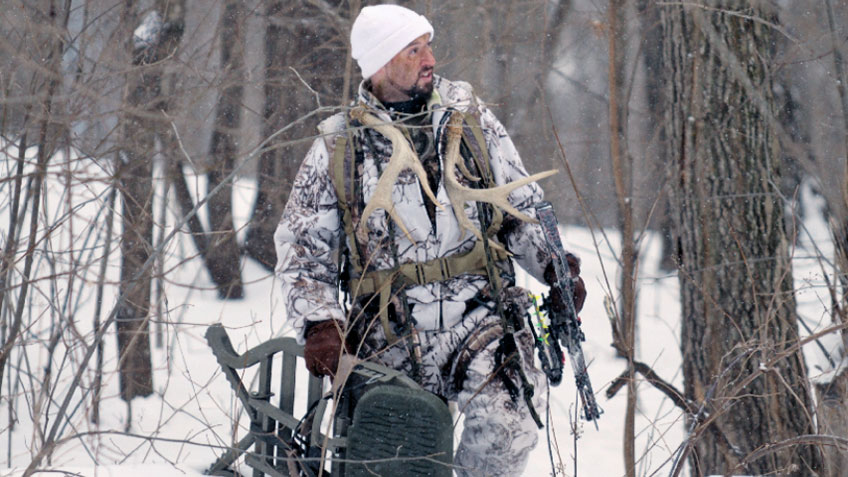
You look over the terrain, think of your stand choices and dream. Maybe the buck you want is one you saw across a field in muggy August or in the headlights one September evening just after it had shed velvet from its gleaming rack. Perhaps you’ve seen the buck with its eyes and rack glowing in a trail-camera photo. In any case, fresh rubs with antler-tine gouges well above the peeled bark give the buck away.
You wonder when and where this buck will be vulnerable in late October and November. The rut isn’t a static event, you’ve learned, but instead is a cycle. To have the best chance of seeing the buck, you must stay in step with the rut’s three basic phases when choosing where to place your stands and which days to hunt them.

SEEK AND CHASE PHASE
When: Oct. 26-Nov. 9
The younger bucks lose their heads during this phase, but the older bucks stay calm. Some does have come into estrus but not many. Older bucks search for these does but not in the mad way they will later when they are between breeding does. Still, just before the rut peaks, even the older bucks will be on their feet searching, which presents a short but incredible opportunity.
Where: Near Buck Bedding Areas
This is the time to hit stands you’re not afraid to burn. I don’t mean to hunt foolishly, but you will have to get near bedding cover in evening or morning setups to kill a mature deer in all but the least-pressured areas at this time. This means leaving a stand at dark right when the buck you are targeting is surest to be near you. You likely won’t even know it if you bump the buck. So roll the dice on some new spots that are not at the top of your list.
Mature bucks are still mostly on a bed-to-feed pattern now. A lot of whitetail researchers who have placed GPS collars on bucks have found that a hunter needs to be within a few hundred yards of where a mature buck is bedded to have a chance of seeing that buck in daylight during this stage of the rut.
You’ll have to hunt heavy cover. Follow rub lines away from feeding areas to find the points bucks use to drop off ridges or exit thick drainages. Try to use low-impact entry and exit routes (streams, ditches, etc.) that will take you to and from your stand without bumping deer or placing you directly upwind of them. But sometimes to have a chance, you simply have to realize you’re going to get one shot at such a place.
So play it right. Hunt during the best wind and, ideally, just after a cold front has moved through or while it’s moving in. Nothing gets deer moving on late-October evenings better than a temperature that has fallen 15-20 degrees.
Last season I used a stream with a muddy bank 15-20 feet high to slip into what I call an “inside corner” on public land. The habitat was once farmland, as crumbled stone walls mark where heavy cover takes a 90-degree turn around a section of old white oaks. It’s a great spot for deer to step out of the thick stuff and sniff out acorns during October evenings. Hunting it, though, takes a south wind. So it was hot the day a large 8-pointer showed but stayed out of range a half-hour before sunset. When the buck began to leave I grunted, and he turned and looked. A younger 8-pointer came right in, convincing the older buck to take those last steps into bow range. The rut was 10 days from its peak, but the buck was interested.

PEAK BREEDING PHASE
When: Nov. 10-25
This starts with a bang, but the days just after the peak of the rut can seem like a lull in activity, especially if a warm front moves in. You’ll stop seeing bucks because many of them are busy breeding. A mature buck will push a doe that’s ready to breed to some out-of-the-way spot to avoid other bucks, and the pair will stay there for 24-36 hours.
Where: Funnels Between Doe Bedding Areas
Now is when you need to sit all day in pinch points between bedding areas. This often means getting back into thick cover in places where the terrain forces deer through narrow funnels. The only way to find these spots is to fight through heavy cover as you check out the terrain you might not clearly see on topographical maps or aerial photos. (You should have already done that; the best time is in late winter when the vegetation is at its thinnest but when rubs and other sign is still visible.)
As these pinch points are created by terrain, you can often use a stream, cliff edge, swamp, steep hill or other landform to get in and out of these places unnoticed by deer. In fact, the best way to find these spots is to follow a terrain feature that deer have a hard time crossing or climbing.
You never know when a mature buck will be between does and actively seeking a willing mate. These are the days when you might see a huge buck in daylight stupidly crossing a road or field. Often the best time to be in the woods now is midday. Get comfortable in a spot between two areas of bedding cover and be patient.

FRANTIC SEARCH PHASE
When: Nov. 26-Dec. 7
As the number of does in estrus fades to only a few, even the older bucks are in a frenzy of travel. They want to find the last does that are ready to breed before it’s all over, aside from the secondary rut (when does, including some fawns, that weren’t bred during the primary peak come into heat 28 days later).
Where: Security Cover
“Phase 2” stands are still the places to be, but there is a big caveat. Hunting pressure now has likely shut down a lot of daytime activity. Studies show pressured bucks continue to move in search of does, but during daylight hours they do this only in heavy cover and other places where experience has taught them they are safe.
Look for those secluded patches of heavy cover no one is bothering to hunt. In the final stage of the rut, mature bucks move around in thick cover slowly searching for does often during the middle of the day. All-day sits still make sense for this reason.
As the number of does in estrus falls to only a few, the bucks will again be searching frantically—but not in open woods or fields during daylight. The best way to find the bucks is to hunt heavy cover where the does are bedding. With the temperature falling and winter coming, also target cover that leads to late-season food sources. Get out there just before or when a cold front is bringing winter weather, as deer worn out from rutting activity feed heavily then.
The rut phases above are listed with approximate dates for much of the whitetail’s range in the Northeast, Midwest and West. Dates can be far different in the Deep South and Texas, and can vary in other regions. Still, the phases run through the same cycle. Knowing the timing of the rut and how to adjust to it, as well as understanding the influence of local hunting pressure, is vital to getting in range of that buck.




































